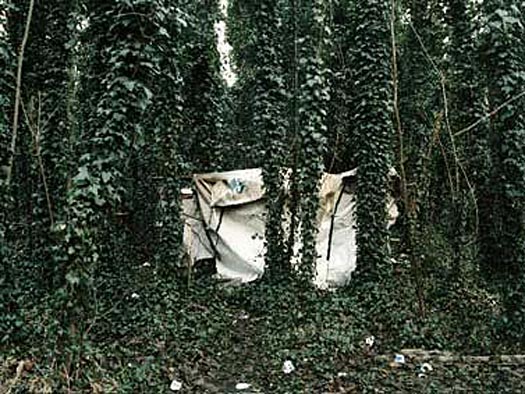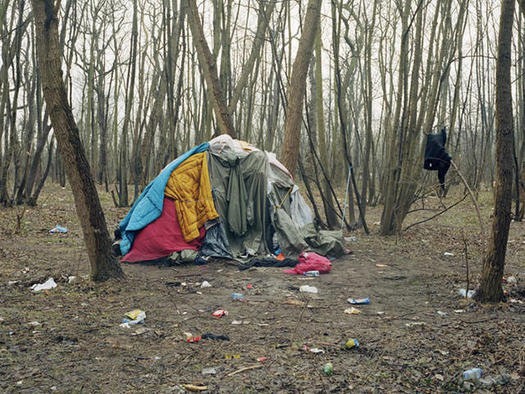
Each year 3.5 million Americans experience homelessness and on any given night, over 700,000 people are without a roof. In Houston alone, some 15,000 homeless people live in abandoned buildings, on cardboard makeshift beds, under freeways and in shelters throughout the city.
In Western Europe, too, the number of homeless people is at its highest level in 50 years. Homelessness has reached levels not seen since the end of World War II - and this is before the main impact of public spending cuts has impacted.
In a photography and book project called Shelter Henk Wildschut documents found shelters: roped-up and tarped in Calais, cardboard-boxed in Patra, thinly-sheeted sheds in Malta, found-objects collaged in Almeria, and simply under trees in Rome.


But who is in them?
Susan Sontag's Regarding The Pain of Others reflected on the role of war photography in shaping how noncombatants respond to its human cost — or not, if they have become numbed.
Sontag questioned the way that fragments of the world were often torn from their context and history and mixed together in a way that Sontag compared to surrealism. "That kind of promiscuous aestheticizing of experience," she wrote, "makes everyone a tourist in other people's reality, and eventually in one's own."
Do contemporary images teach us about suffering, Sontag famously asked, or do they numb us over time and simply cause us to turn away?
Sontag's question is a live one today. Human beings are labelled loosely as "the homeless" — but we seldom learn who “they” are.
Happily there are exceptions. In Seattle, Erika Schultz, has documented what she calls Invisible Families. Parents with children are the fastest growing yet least visible sector of the homeless population. Families stay hidden away — doubling up with friends or staying in emergency shelters.

Schultz gives a name and a narative to her images. "Here, Jack Ahern, aged nine, marches with a bamboo stick while staying at a city, located in Skyway. Sometimes, Jack would enlist fellow ‘Nickelodeons’ to help him look for worms. On other days, he'd play on a pogo stick, in mud puddles or with the resident camp kitten that had six digits on one paw. The bamboo stick was a gift."
In a recent combind oral history and photography show in Minneapolis, Homeless is my address not my name visitors learn more than usual about the people in the portraits. Underneath about a third of the portraits are phone numbers visitors can call to hear the person in the picture tell their story. These recordings begin with their name, and where they stayed last night.
But the headline on the Seattle Times website still reads: "Voices of the homeless featured in photography show."
This writer is ill-equipped to add new insight to the ethics of photojournalism. [An online book called Photojournalism An Ethical Approach covers the ground well; and a study commissioned by the University of Illinois lists some two dozen different codes and guidelines]
But with an exhibition of artists' and photography books opening this week in Paris, two questions seem to me to be as live as ever: Is it enough for these images to be striking? Or is there a danger, as we we saw with climate porn that we will become de-sensitized?
But even those are self-centered concerns. Perhaps we should not judge these images by what they make *us* feel, but by the extent to which they cause to connect, one-to-one, with the people they portray.


Comments [2]
04.05.11
03:13
04.05.11
03:13